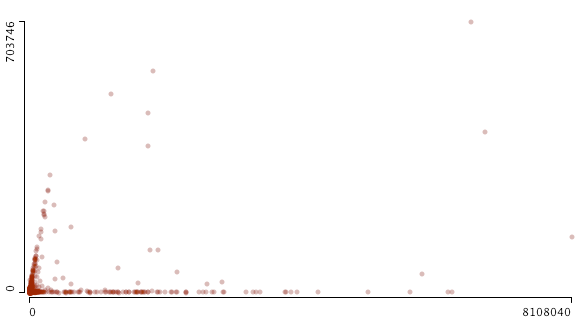When Lawrence Lessig famously stated that “code is law”, the most simple and striking example was AOL’s decision to – arbitrarily – limit the number of people that could log into a chat room at the same time to 23. While the social consequences of this rule were quite far-reaching, they could be traced to a simple line of text somewhere in a script stating that “limit = 23;” (apparently someone changed that to “limit = 36;” a bit later).
When starting to work on a data exploration project linking Web sites to Twitter, I wasn’t aware that the microblogging site had similar limitations built in. Somewhere in 2008, Twitter apparently capped the number of people one can follow to 2000. I stumbled over this limit by accident when graphing friends and followers for the 24K+ accounts we are following for our project:
This scatterplot (made with Mondrian, x: followers / y: friends) shows the cutoff quite well but it also indicates that things are a bit more complicated than “limit = 2000;”. From looking at the data, it seems that a) beyond 2000, the friend limit is directly related to the number of followers an account has and b) some accounts are exempt from the limit. Just like everywhere else, there are exceptions to the rule and “all are equal before the law” (UN Declaration of Human Rights) is a standard that does not apply in the context of a private service.
While programmed rules and limits play an important role in structuring possibilities for communication and exchange, a second graph indicates that social dynamics leave their traces as well:
This is the same data but zoomed out to include the accounts with the highest friend and follower count. There is a distinct bifurcation in the data, two trends emerging at the same time: a) accounts that follow the friend/follower limit coupling and b) accounts that are followed by a lot of others while not following many people themselves. The latter category is obviously celebrity accounts such as David Lynch, Paul Krugman, or Karl Lagerfeld. These brands are simply using Twitter as a one-to-many medium. But what about the first category? A quick examination confirms that these are Internet professionals, mostly from marketing and journalism. These accounts are not built on a transfer of social capital (celebrity status) from the outside, but on continuous cross-platform networking and diligent posting. They have to play by different rules than celebrities, reciprocating follower connections and interacting with other accounts to abide by the tacit rules of the twitterverse. They have built their accounts into mass media as well but had to work hard to get there.
These two examples show how useful data visualization can be in drawing our attention to trends in the data that may be completely invisible when looking at the tables only.
Tech support questions will not be answered. Please refer to the FAQ of the tool.


2 Comments